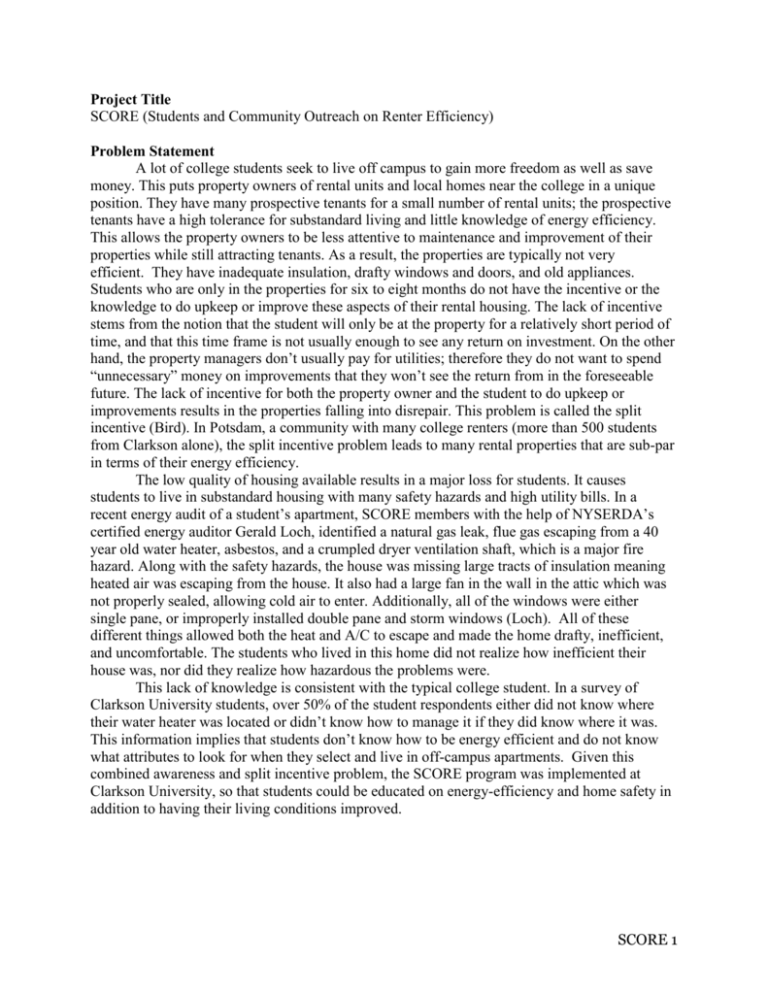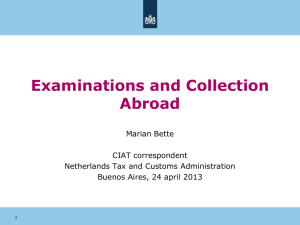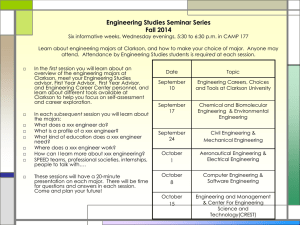Clarkson`s $core Program
advertisement

Project Title SCORE (Students and Community Outreach on Renter Efficiency) Problem Statement A lot of college students seek to live off campus to gain more freedom as well as save money. This puts property owners of rental units and local homes near the college in a unique position. They have many prospective tenants for a small number of rental units; the prospective tenants have a high tolerance for substandard living and little knowledge of energy efficiency. This allows the property owners to be less attentive to maintenance and improvement of their properties while still attracting tenants. As a result, the properties are typically not very efficient. They have inadequate insulation, drafty windows and doors, and old appliances. Students who are only in the properties for six to eight months do not have the incentive or the knowledge to do upkeep or improve these aspects of their rental housing. The lack of incentive stems from the notion that the student will only be at the property for a relatively short period of time, and that this time frame is not usually enough to see any return on investment. On the other hand, the property managers don’t usually pay for utilities; therefore they do not want to spend “unnecessary” money on improvements that they won’t see the return from in the foreseeable future. The lack of incentive for both the property owner and the student to do upkeep or improvements results in the properties falling into disrepair. This problem is called the split incentive (Bird). In Potsdam, a community with many college renters (more than 500 students from Clarkson alone), the split incentive problem leads to many rental properties that are sub-par in terms of their energy efficiency. The low quality of housing available results in a major loss for students. It causes students to live in substandard housing with many safety hazards and high utility bills. In a recent energy audit of a student’s apartment, SCORE members with the help of NYSERDA’s certified energy auditor Gerald Loch, identified a natural gas leak, flue gas escaping from a 40 year old water heater, asbestos, and a crumpled dryer ventilation shaft, which is a major fire hazard. Along with the safety hazards, the house was missing large tracts of insulation meaning heated air was escaping from the house. It also had a large fan in the wall in the attic which was not properly sealed, allowing cold air to enter. Additionally, all of the windows were either single pane, or improperly installed double pane and storm windows (Loch). All of these different things allowed both the heat and A/C to escape and made the home drafty, inefficient, and uncomfortable. The students who lived in this home did not realize how inefficient their house was, nor did they realize how hazardous the problems were. This lack of knowledge is consistent with the typical college student. In a survey of Clarkson University students, over 50% of the student respondents either did not know where their water heater was located or didn’t know how to manage it if they did know where it was. This information implies that students don’t know how to be energy efficient and do not know what attributes to look for when they select and live in off-campus apartments. Given this combined awareness and split incentive problem, the SCORE program was implemented at Clarkson University, so that students could be educated on energy-efficiency and home safety in addition to having their living conditions improved. SCORE 1 Project Summary/Background The SCORE Program at Clarkson University was adapted from a similar program at the University of Colorado at Boulder. The idea behind the project is to provide energy saving “widgets” which are small devices like low flow shower heads, CFL bulbs, sink aerators, weather stripping, and window film, to the students free of charge, so that they don’t feel the pinch when improving the energy efficiency of their off-campus housing. The program also teaches student renters how to live efficiently and how small changes in their habits can make a huge difference, both environmentally and economically. SCORE is also designed to identify possible safety hazards. We found that there were many safety issues that students didn’t even know could be dangerous. SCORE provides contacts to students or their landlords to help solve safety issues. The uniqueness of the SCORE program comes from solving two problems at once. Not only is energy and resource consumption being reduced, but student-renters are also being educated on how to perpetuate sustainable lifestyles. So the true benefit of SCORE is not only the immediate reduction of energy and resource consumption, but also the life-long knowledge the student-renters attain during the audit itself. Before SCORE was started at Clarkson University there were no comparable projects dealing with student off campus housing. While Clarkson has made great strides in recent years to increase the energy efficiency of its on campus buildings little has been done for the off campus housing stock. Except for a handful of free CFL give a-ways, off campus housing projects are none existent. SCORE sought to fill that unoccupied niche with a combination of education and small scale hardware upgrades. A year was spent preparing, organizing, and planning for everything that would be needed to perform a group of houses as a pilot program. We plan to perform 25 audits next semester in the surrounding community, and in subsequent years, we plan to widen our range of audits to include the surrounding communities and colleges as well. Relationship to Sustainability The implications of this program extend beyond student life at Clarkson. The project has provided knowledge and experience that is applicable to any living situation, and in doing so, will allow the students involved to bring their newfound knowledge and experience to any living situation they find themselves in, widening the impact of the project further. This ripple of knowledge will carry outwards, resulting in increased renter efficiency and the decrease of negative environmental impacts. SCORE has helped to improve the community overall, by going out into town where people other than college students are, there is more awareness being brought about. Property owners will learn about the improvements that were made on the houses that they own. This can encourage the home owner to make similar changes in their own homes. The members of SCORE also benefit from this program. SCORE members have been provided with invaluable information about energy that they can apply to future homes. As well as being a highly applicable skill, this experience is a valuable resume piece. It shows their level of dedication and hands-on experience in the field of energy-efficiency. This semi-professional experience has granted them skills that will stand out as they continue their careers. SCORE 2 Materials and Methods To implement the project, two students were trained to perform basic energy and safety audits by a SUNY Canton Professor who is a trained energy auditor. Each of the trained auditors was paired with an assistant to conduct the actual audits. Materials, including tools and the energy saving widgets, were purchased. After student-renters were contacted via email, the SCORE teams performed four audits in the Potsdam community. At the beginning of each audit, the renters were asked a series of questions about their knowledge and behavior pertaining to the sustainability of the rental unit. Then, the SCORE team used a check-list to audit the apartment, assessing the efficiency of the rental unit itself, i.e. drafts, leaks, inefficient lights, inefficient faucets and showerheads, etc., and documenting everything they encountered. Specific problems were identified and solved where feasible with the supply of efficiency widgets. The SCORE check list also included several safety hazards that the SCORE team evaluated. These hazards included checking dryer vents, paying attention to any loose hanging pipe tape that could have potentially been friable asbestos, as well as using a flammable gas detector to look for gas leaks in their furnace pipes. Apart from those major safety hazards, audit teams also checked to make sure each apartment had adequate smoke detectors, or did not inappropriately use extension cords or power strips that could lead to electrical fires. Energy efficiency and student safety are main concerns to SCORE, but one of the main objectives was also to educate the renters. The auditors explained everything they were doing and how it helped efficiency and sustainability while the audit was being performed. A month after the audit was completed; the renters were sent a post-survey, so the level of behavioral change and education could be quantified. The pre and post surveys focused on the behavioral aspect of the student renters. Using the surveys, we were able to find out if the students knew where their thermostat was, if they turned the lights off when they left a room, if they knew what storm windows were, etc. By gauging their knowledge of sustainability before the audit, we are able to see the results of their education, and know if their behavior has switched at all as a result of the audits. Because our project used students as research subjects, IRB approval was granted to SCORE so we could perform our audits within the IRB guidelines. Materials used include low flow shower heads, CFL bulbs, sink aerators, weather stripping, and window film. Tools used to help auditors implement these devices and collect data include screwdrivers, buckets, flashlights, thermometers, plumbing tape, tool boxes, work gloves, hair dryers, pliers, and a flammable gas detector. The data from these audits was collected, quantified, and analyzed by the SCORE team. Metrics tracked include the amount of water saved, the change in energy (kwh and therms) from before and after the audit, and the amount of energy saving devices they had installed prior to the audit, among many others. Results, Evaluation and Demonstration Clarkson University’s SCORE program has had direct impacts on the community, on students, and transitively on the world. On average, assuming each bulb is used for 4 hours a day, each of the four houses we audited are saving nearly $42 per year just from switching their incandescent light bulbs to CFLs, and switching their showerheads to a showerhead rated for 1.5 gallons per minute. The impacts of these savings go beyond a monetary value however. The students who see what becoming more efficient does to their bill will carry that knowledge with them as they move to other living arrangements throughout the remainder of their lives. This SCORE 3 diffusion of knowledge will help reduce energy consumption in future generations and reduce carbon emissions. Our pre and post surveys show a positive impact on the behavior of the students that were involved. The pre survey showed us that 75% of students didn’t know where their water heater was, and one student didn’t even know what kind of heating device heated her house. Another thought it was way better to keep their heat off and turn on 3-4 space heaters and keep them on all of the time. All of these issues were mediated during the audits. The post surveys show a significant improvement in renter efficiency. 75% of the students audited now unplug their kitchen appliances when they are not in use, and they always left them plugged in prior to the audits. 50% of the student-renters audited now turn their heat down at night to conserve energy. Some of the other changes are sporadic among the houses. One house now keeps its thermostat 5 degrees less than what it did beforehand. One student has made it a habit to purchase only energy-efficient heaters from now on. Overall, the student feedback was very positive. Money was saved, and they all enjoy the changes that were made to their homes. To give some perspective for the immediate environmental impacts of our project, just by switching their current light bulbs to more efficient ones, we’ve managed to save about 860 pounds of carbon dioxide from entering the atmosphere per year for these four audits (Power). Aside from the carbon emissions reduced, by changing the showerhead in just one living unit to a more efficient one, we’ve saved approximately 7300 gallons water per year. This reduction in the use of our resources has a positive impact on our environment by both conserving energy and water, while also reducing carbon dioxide emissions. The SCORE program at Clarkson is based on currently existing SCORE programs at Colorado University at Boulder, University of Oregon, and University of Wisconsin- Eau Claire. Clarkson’s SCORE program, being the fourth implemented in a diverse group of schools with a wide range of student populations, climates, and geographic location, has proven that this project can be implemented anywhere where the split incentive exists. Meaning, any town where college students are looking to rent homes for semester long intervals, a SCORE program can be implemented. If SCORE programs continue to exist, and more are created, then an economic and societal shift to a more energy-efficient future can be propagated. To ensure SCORE’s continued presence at Clarkson University, we are currently on our way to becoming a Clarkson recognized club, so that we may possibly receive funding from the university in the future. Also, we have been and will continue working with the philanthropy office at Clarkson University so that we may better search for and apply to grants. To represent the immediate impacts of SCORE, we will present a poster displaying different data and graphs that properly demonstrate the different effects of our project. Conclusions Through a two-semester long implementation of the SCORE program at Clarkson, we have learned that the knowledge about energy-efficiency among the student population is mixed; some students have energy-efficient appliances in place while others don’t; some students are well aware of the impacts their choices and habits have on themselves, society, the economy, and the environment, while others are wholly ignorant. In short, we have two extremes, and the majority of students fall in between these extremes. This affords us a great opportunity to educate students and increase renter efficiency in the Potsdam community. SCORE 4 In regards to the future of this program, several things can be done to improve our results. Four audits were completed in the last two semesters in association with this NYSP2I grant, so the data pool is very small. In the Fall 2014 semester, we plan on completing twentyfive audits, which will provide an ample amount of data to represent our findings. Another improvement to our project is the increased experience amongst our auditors. With more experienced auditors, the audits will run more smoothly, data acquisition will be more efficient, and the quality of the data will increase. There is significant uncertainty in the assumptions made to quantify heat and electricity savings. After the audits were performed, the average outside temperature decreased steadily, so the heating bills went up. Student renters spent more money to heat their apartments after the audits were performed, so there is no reliable method to quantify the amount of therms our upgrades saved because of this temperature decrease. The sink aerators and low flow showerheads save water from being heated, but there are too many variables to accurately predict how many therms are saved from the amount of water not being heated. A goal for the next semester is to develop a way to accurately predict and quantify the amount of therms saved by our widgets. Large problems exist in college towns all over the world. Student-rented homes are falling into a state of inefficiency due to the split incentive. However, with a few small changes, this degradation can be slowed and even stopped. By providing CFLs and other energy-saving devices, SCORE has given students the incentive to become energy efficient, and as a result the SCORE program has made a large impact on the environment and society. References Bird, Stephen. "Policy Options for the Split Incentive: Increasing Energy Efficiency for Lowincome Renters." Policy Options for the Split Incentive: Increasing Energy Efficiency for Lowincome Renters. N.p., n.d. Web. 08 Apr. 2014. "Power Profiler." How Clean Is the Electricity I Use? -. N.p., n.d. Web. 06 Apr. 2014. "SCORE." University of Colorado Boulder. N.p., n.d. Web. 08 Apr. 2014. SCORE 5




